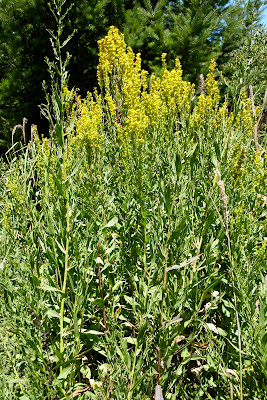 |
| Day of the Dead Marigolds (companion planted with tomatoes, asparagus, parsley) Buckeye Butterfly and Morman Metalmark Butterfly nectaring |
With global climate change deeply embedded on our planet, our “normal” hot, dry September and October only occasionally visits, however here in late October it is in full force. Delightful! I just love working outside getting all hot and sweaty with the full sun embracing my body as I work. During those wonderfully hot, sunny days when all the native plants are resting (dormant, in estivation), I tackled nonnative removal. First the Hot Poker, aka Kniphofia uvaria, native to South Africa and extremely drought tolerant, which I originally moved to MuRefuge from our place on Cunningham Road where we had Baltimore Orioles who loved the nectar the bright yellow and orange flowers provided. Alas, rare to none of these gorgeous birds come here to MuRefuge. Those few transplants over the eighteen years here at MuRefuge grew to a sizeable number. As I was pulling, chopping, covering with our no longer wearable natural fiber clothes, cardboard and newspaper then arbor mulch from Grab n’ Grow, I was struck by the lack of any creepy crawly life . . . no lizards, no snakes, no insects of any kind did I observe.
 |
| Native Goldenrod will fill in area where the Hot Poker plants were removed |
A few days later on another sunny day, I moved across the driveway to remove the substantial bed of just beginning to bloom Naked Lady, aka Amaryllis belladonna, also a native to South Africa that thrives in most any kind of soil without any watering. A well meaning friend gave me a few bulbs when we moved to MuRefuge and had essentially a barren garden. I cut all the just beginning to bloom stocks, brought them into the house and stuck them into a huge vase. The arrangement was not attractive since the stems drooped from the weight of the buds. I left them and returned to the task at hand of digging up all of the bulbs. Oh my gosh, I did not have any idea how many there were! I filled up some dozen cardboard boxes and a huge black plastic bag I had brought home from Harmony Farm Supply last Winter with a bare root apple tree. The first 6 boxes I set near the mailboxes, the second six I dropped off at various nearby intersections, and the large black plastic bag I just left at the end of the driveway. “In a hot New York minute”, as my friend Lynette would say, all the bulbs disappeared. Again, being observant to life other than human I noticed none among the bulbs. On a joyful note we did enjoy the fragrance of the Naked Lady flowers for well past a week.
 |
| Native aster sprawling in the front providing late Fall nectar and Common Checkered Skipper |
 |
| Lustrous Copper nectaring on native aster flowers |
Whew! I am so happy to have these nonnatives out of MuRefuge as well as the ornamental pomegranate bush, aka Punica granatum ‘Nana’, and Apple Blossom camellia, aka Camellia sasanqua. Clearing plants, just like clearing ones living quarters of clutter, provides space for native ones.
Then in preparation for the massive project of replacing all of the failed siding on our house, I pruned back all the natives around the perimeter of the house. In doing so I was absolutely astounded by the number of native insects, frogs, caterpillars I saw in the process. Last Winter I read Douglas W. Tallamy’s book Bringing Nature Home: How You Can Sustain Wildlife with Native Plants where he writes that native oaks support some 500+ species of insects while non-native ones less than a dozen. While I was impressed with his entomology statistics, I was astounded seeing it with my own eyes in my own habitat, MuRefuge.
 |
| West Coast Lady nectaring on Day of the Dead marigold |
Please feel free to share below your personal experiences with native plants and their benefits. And
